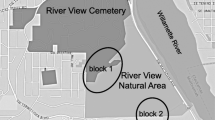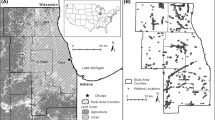Abstract
Urbanization is a leading cause of species loss in the United States because of habitat destruction and fragmentation. Wetlands can be affected by urbanization and the condition of wetlands can be compared across land use categories. Cypress domes are isolated wetlands dominated by cypress (Taxodium distichum) and often remain in urban areas. The purpose of this study was to quantify the effects of urbanization on cypress dome number, size and spatial pattern through two decades of rapid urbanization in Orlando, Florida, a large city in the southeastern US. Over 3,000 cypress domes, in a region typical of urban growth in the cypress range, were identified in images from 1984. Over a 20-year period, 26 % were destroyed or degraded (i.e., no longer cypress-dominated) and almost half in managed forests were degraded, destroyed, or became surrounded by urban or agricultural land uses. The smallest and largest cypress domes were lost, leaving only medium-sized wetlands and decreasing landscape-level diversity. Despite the fact that these wetlands are common and partially protected by legislation, cypress in isolated wetlands may be at risk from urbanization.





Similar content being viewed by others
References
Beyer HL (2004) Hawth’s analysis tools for ArcGIS. http://www.spatialecology.com/htools
Biamonte E, Sandoval L, Chacón E, Barrantes G (2011) Effect of urbanization on the avifauna in a tropical metropolitan area. Landscape Ecology 26:183–194. doi:10.1007/s10980-010-9564-0
Blazquez CH (1992a) Cypress tree-stress detection with color infrared film. Journal of Imaging Science and Technology 36:487–490
Blazquez CH (1992b) Detection of pond cypress tree-stress using color infrared aerial-photography with image-analysis. Journal of Imaging Science and Technology 36:196–200
Brandt K, Ewel KC (1989) Ecology and management of Cypress swamps: a review. University of Florida Cooperative Extension Service, Bulletin 252, Gainesville, FL
Burns RM, Honkala BH (1990) Silvics of North America: 1. Conifers. Agricultural handbook 654. United States Department of Agriculture, Forest Service, Washington, D.C
Casey W, Ewel KC (2006) Patterns of succession in forested depressional wetlands in North Florida, USA. Wetlands 26:147–160
Craig RK (2002) Lower courts untangle the finer points of the SWANCC decision. National Wetlands Newsletter 24:7–10
Czech B, Krausman PR, Devers PK (2000) Economic associations among causes of species endangerment in the United States. BioScience 50:593–601
Dale M, Fortin M-J (2002) Spatial autocorrelation and statistical test in ecology. Ecoscience 9:162–167
Demaree D (1932) Submerging experiments with Taxodium. Ecology 13:258–262
Duguay S, Eigenbrod F, Fahrig L (2006) Effects of surrounding urbanization on non-native flora in small forest patches. Landscape Ecology 22:589–599. doi:10.1007/s10980-006-9050-x
ESRI (2006) ArcGIS v9.2. ESRI, Environmental Systems Research Institute, Redlands, CA
ESRI (2009a) ArcGIS v9.3. ESRI, Environmental Systems Research Institute, Redlands, CA
ESRI (2009b) Multi-distance spatial cluster analysis (Ripley’s k-function). http://resources.esri.com/help/9.3/arcgisdesktop/com/gp_toolref/spatial_statistics_tools/multi_distance_spatial_cluster_analysis_ripley_s_k_function_spatial_statistics_.htm
Ewel KC (1998) Pondcypress swamps. In: Messina MG, Conner WH (eds) Southern forested wetlands. Lewis Publishers, Boca Raton, pp 405–420
Ewel KC, Odum HT (1985) Cypress swamps. University Presses of Florida, Gainesville
FDEP (Florida Department of Environmental Protection) (2007) Summary of the wetland and other surface water regulatory and proprietary program in Florida. Tallahassee, FL. http://www.dep.state.fl.us/water/wetlands/docs/erp/overview.pdf
Fleishman E, Launer AE, Switky KR, Yandell U, Heywood J, Murphy DD (2001) Rules and exceptions in conservation genetics: genetic assessment of the endangered plant cordylanthus palmatus and its implications for management planning. Biological Conservation 98:45–53. doi:10.1016/S0006-3207(00)00140-3
Gladstone DL (1998) Tourism Urbanization in the United States. Urban Affairs Review 34:3–27
Godt MJW, Hamrick J, Bratton S (1995) Genetic diversity in a threatened wetland species, Helonias bullata (Liliaceae). Conservation Biology 9:596–604
Haag K, Lee T (2010) Hydrology and ecology of freshwater wetlands in central Florida—a primer: U.S. Geological Survey Circular 1342:138
Hanksi I, Gilpin M (1991) Metapopulation dynamics: brief history and conceptual domain. Biological Journal of the Linnean Society 42: 3–16
Hanski I (1998) Metapopulation dynamics. Nature 396:41–49
Herault B, Thoen D (2009) How habitat area, local and regional factors shape plant assemblages in isolated closed depressions. Acta Oecologica 35:385–392
Jenerette GD, Potere D (2010) Global analysis and simulation of land-use change associated with urbanization. Landscape Ecology 25:657–670. doi:10.1007/s10980-010-9457-2
Leeds JA, Garrett PB, Newman JM (2009) Assessing impacts of hydropattern restoration of an overdrained wetland on soil nutrients, vegetation and fire. Restoration Ecology 17:460–469. doi:10.1111/j.1526-100X.2008.00381.x
Leibowitz SG (2003) Isolated wetlands and their functions: an ecological perspective. Wetlands 23:517–531
Lickey EB, Walker GL (2002) Population genetic structure of baldcypress (Taxodium distichum L. Rich. var. distichum) and pondcypress (T. distichum var. imbricarium [Nuttall] Croom): biogeographic and taxonomic implications. Southeastern Naturalist 1:131–148
Ma Z, Cai Y, Li B, Chen J (2009) Managing wetland habitats for waterbirds: an international perspective. Wetlands 30:15–27
MacArthur RH, Wilson EO (1967) The theory of island biogeography. Princeton University Press, Princeton
McCauley LA, Jenkins DG (2005) GIS-based estimates of former and current depressional wetlands in an agricultural landscape. Ecological Applications 15:1199–1208. doi:10.1890/04-0647
McCauley LA, Jenkins DG, Quintana-Ascencio PF (2012) Reproductive failure of a long-lived wetland tree in urban lands and managed forests. Journal of Applied Ecology In press
McDonald R, Kareiva P, Forman R (2008) The implications of current and future urbanization for global protected areas and biodiversity conservation. Biological Conservation 141:1695–1703
McKinney ML (2002) Urbanization, biodiversity, and conservation. BioScience 52:883–890
McKinney ML (2006) Urbanization as a major cause of biotic homogenization. Biological Conservation 127:247–260. doi:10.1016/j.biocon.2005.09.005
Middleton BA (1999) Wetland restoration, flood pulsing and disturbance dynamics. Wiley, New York
Oertli B, Joye DA, Castella E, Juge R, Cambin D, Lachavanne JB (2002) Does size matter? The relationship between pond area and biodiversity. Biological Conservation 104:59–70
Penfound WT (1952) Southern swamps and marshes. The Botanical Review 18:413–446
R Development Core Team (2011) R: a language and environment for statistical computing. http://www.r-project.org/
Reardon J, Hungerford R, Ryan K (2007) Factors affecting sustained smouldering in organic soils from pocosin and pond pine woodland wetlands. International Journal of Wildland Fire 16:107. doi:10.1071/WF06005
Scheffer M, van Geest GJ, Zimmer K, Jeppesen E, Søndergaard M, Butler MG, Hanson MA, Declerck S, De Meester L (2006) Small habitat size and isolation can promote species richness: second-order effects on biodiversity in shallow lakes and ponds. Oikos 112:227–231. doi:10.1111/j.0030-1299.2006.14145.x
Semlitsch RD, Bodie JR (1998) Are small, isolated wetlands expendable? Conservation Biology 12:1129–1133
Solid Waste Agency of Northern Cook County (SWANCC) v. U.S. Army Corps of Engineers (2001) 531 U.S. 159. 2001. 531 U.S.: 159
St. Johns River Water Management District (1984) 1984 NHAP color infrared photograph. http://floridaswater.com/gisdevelopment/docs/metadata/nhap1984.htm
St. Johns River Water Management District (1990) SJRWMD land use and land cover (1990). http://floridaswater.com/gisdevelopment/docs/metadata/luse1990.htm
St. Johns River Water Management District (2006) SJRWMD land use and land cover (2004). http://floridaswater.com/gisdevelopment/docs/metadata/luse2004.htm
Tsumura Y, Tomaruà N, Suyama Y, Bacchus S (1999) Genetic diversity and differentiation of taxodium in the south-eastern United States using cleaved amplified polymorphic sequences. Heredity 83:229–238
U.S. Census Bureau (2000) Metropolitan area population estimates for July 1, 1999 and population change for April 1, 1990 to July 1, 1999. http://www.census.gov/popest/data/metro/totals/1990s/tables/MA-99-01.txt
U.S. Census Bureau (2010) Table 7. Cumulative estimates of population change for metropolitan statistical areas and rankings: April 1, 2000 to July 1, 2009 (CBSA-EST2009-07). www.census.gov/popest/metro/tables/2009/CBSA-EST2009-07.xls
U.S. Department of Agriculture-Natural Resource Conservation Service (2004) Digital ortho quad county mosaic-color infrared. http://datagateway.nrcs.usda.gov/Catalog/ProductDescription/MDOQ1M_C.html
United Nations Population Fund (2007) The state of the world population 2007: unleashing the potential of urban growth. 45:99. http://www.unfpa.org/webdav/site/global/shared/documents/publications/2007/695_filename_sowp2007_eng.pdf
University of Florida/IFAS Extension (2006) Florida forest stewardship - wetlands regulation. http://www.sfrc.ufl.edu/Extension/florida_forestry_information/planning_and_assistance/wetlands_regulations.html
van der Valk AG, Pederson RL (2003) The SWANCC decision and its implications for prairie potholes. Wetlands 23:590–596
Whigham DF, Jordan TE (2003) Isolated wetlands and water quality. Wetlands 23: 541–549
Xu K, Kong C, Wu C, Liu G, Deng H, Zhang Y (2009) Dynamic changes in Tangxunhu wetland over a period of rapid development (1953–2005) in Wuhan, China. Wetlands 29:1255–1261
Acknowledgments
We thank K.A. Medley for reviewing this manuscript and K.C. Ewel for advice and support. We would like to thank anonymous reviewers for their assistance and advice while reviewing this manuscript. This project was partially funded by the Florida Native Plant Society Endowment Research Grant. We thank the Ying Family Foundation for their continuing support.
Author information
Authors and Affiliations
Corresponding author
Electronic supplementary material
Below is the link to the electronic supplementary material.
Online Fig. 1
A cypress dome outlined in yellow on a color-infrared photo. (PDF 656 kb)
Online Table 1
Table of original land use classifications and the re-categorized land cover groups. (PDF 199 kb)
Online Fig. 2
Habitat degradation shown in photos from 1984 (a) where grey cypress domes are easily distinguished from pink upland vegetation. By 2004 (b) the same wetlands could not be readily distinguished from the upland vegetation. (PDF 225 kb)
Rights and permissions
About this article
Cite this article
McCauley, L.A., Jenkins, D.G. & Quintana-Ascencio, P.F. Isolated Wetland Loss and Degradation Over Two Decades in an Increasingly Urbanized Landscape. Wetlands 33, 117–127 (2013). https://doi.org/10.1007/s13157-012-0357-x
Received:
Accepted:
Published:
Issue Date:
DOI: https://doi.org/10.1007/s13157-012-0357-x




